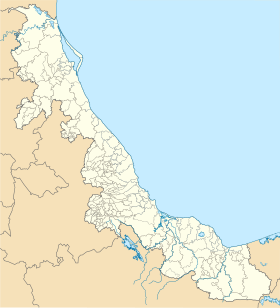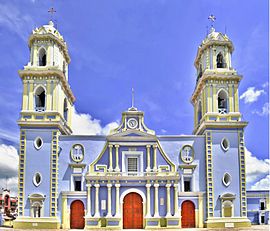Cordoba (Veracruz)
| Cordoba | |
|---|---|
|
Coordinates: 18 ° 53 ′ N , 96 ° 55 ′ W
Cordoba on the map of Veracruz
|
|
| Basic data | |
| Country | Mexico |
| State | Veracruz |
| Municipio | Cordoba |
| City foundation | April 27, 1618 |
| Residents | 140,896 (2010) |
| City insignia | |
| Detailed data | |
| height | 860 m |
| Post Code | 94500 |
| prefix | (+52) 271 |
| Time zone | UTC −6 |
| Website | |
|
The City Hall ( Palacio Municipal ) |
|
| The Cathedral of Cordoba ( Catedral de la Inmaculada Concepción ) | |
Córdoba is a city with around 140,000 inhabitants (2010: 140,896) in the Altas Montañas region in the Mexican state of Veracruz .
Córdoba is the seat of the Roman Catholic diocese of Córdoba .
history
The city was founded in 1618 at the instigation of the viceroy Diego Fernández de Córdoba , whose name it was named, to protect merchants on the road from Veracruz to Mexico City against attacks by runaway black slaves.
In August 1821, the Mexican revolutionary Agustín de Iturbide and the Spanish viceroy Juan O'Donojú signed the Treaty of Cordoba , which ratified the Iguala plan and sealed Mexico's independence. In 1973 the city was badly damaged by an earthquake. Due to the convenient location of Cordoba on the 150 motorway , the city has developed into a popular tourist and excursion destination.
Road structure
The central axis is Calle 1, which runs from northeast to southwest, and Avenida 1, which runs from northwest to southeast. They determine the classification system for the other streets. To the northwest of Calle 1 run the calles with the even numbers (first Calle 2, then Calle 4, and so on) and to the southeast of it those with the odd numbers (first Calle 3, then Calle 5, and so on). To the northeast of Avenida 1, the Avenidas with the even numbers run according to the same pattern and those with the odd numbers to the southwest of this run.
The meeting of Calle 1 with Avenida 1 forms the center of the city. At their intersection is the central Parque 21 de Mayo , which is also bordered by Avenida 3 and Calle 3. Its name recalls a historic battle in the Mexican War of Independence that took place in Cordoba on May 21, 1821. Almost all of the city's important buildings are in its immediate vicinity.
Buildings at Parque 21 de Mayo
The northwestern side of the plaza (at Calle 1, which is interrupted for car traffic at this point) is occupied by the Palacio Municipal , which was built in 1905 and which also houses the historical city archive. This is where the original founding documents of the city are kept as well as a certified copy of the Treaty of Cordoba . Immediately behind the town hall is the Teatro Pedro Díaz, which opened in 1896 (with the entrance on Avenida 1), and across from it is the entrance to the ex-convento Santa Rosa de, which takes up the entire block between Avenida 1 and Avenida 2 and Calle 1 and Calle 2 Lima .
The north-eastern flank of the plaza (on Avenida 1) is dominated by the Portal de Zevallos , which today houses various restaurants and cafes. The Mexican Declaration of Independence was signed in this building in 1821.
The Catedral de la Inmaculada Concepción, built in the late 17th and early 18th centuries, is located on the south-eastern side of the plaza (at Calle 3, which is interrupted for car traffic at this point) . The cathedral was created through the extensive renovation of a church built in 1621.
Opposite the cathedral - south of the intersection of Calle 3 and Avenida 3 - there is the Portal de la Gloria , whose winding courtyard garden allows its guests to have intensive contact with nature in complete peace and seclusion. The building is also known as La Favorita because it is used as accommodation for high-ranking guests such as Agustín de Iturbide (1783–1824), Emperor Maximilian (1832–1867) and his wife Charlotte (1840–1927), Benito Juárez (1806– 1872) and José Vasconcelos (1882–1959) served. The complex also houses the Museo de la Ciudad with entrance on Calle 3. The City Museum was founded in 1975 houses, among other several important finds from the cultures of the Totonac and Olmec , two in the Gulf region beheimateter Indian tribes .
To the southwest of the plaza is the Ex-casino Español , located on Avenida 3 , which extends over the entire area between Calle 1 and Calle 3.
economy
Córdoba is the regional center of the coffee and sugar industry as well as an important hub for the marketing of tropical fruits.
Town twinning
Sister cities of Cordoba are
|
|
Born in Cordoba
- Rafael Delgado (1853-1914), writer
- Jorge Cuesta (1903–1942), chemist, writer and editor
- Fernando Casas Alemán (1905–1968), governor of the Mexican state of Veracruz and ambassador
- Santiago González (born 1983), tennis player
- Miguel Layún (* 1988), football player
Web links
- Enciclopedia de los Municipios y Delegaciones de México: Córdoba (Spanish)
Individual evidence
- ^ Catálogo de Localidades ( Spanish ).
- ↑ Vis à vis: Mexico. Dorling Kindersley Verlag GmbH, Starnberg, ISBN 3-928044-13-3 , p. 251.
- ↑ Guía Turística Altas Montañas del Estado de Veracruz (undated, published 2009), p. 19.
- ↑ Guía Turística Altas Montañas del Estado de Veracruz (undated, published 2009), p. 20.
- ↑ Guía Turística Altas Montañas del Estado de Veracruz (undated, published 2009), p. 22.
- ^ The State of Veracruz. Ediciones Nueva Guía, SA de CV, p. 129.
- ^ The State of Veracruz. Ediciones Nueva Guía, SA de CV, p. 132.
- ↑ DB-City.com



